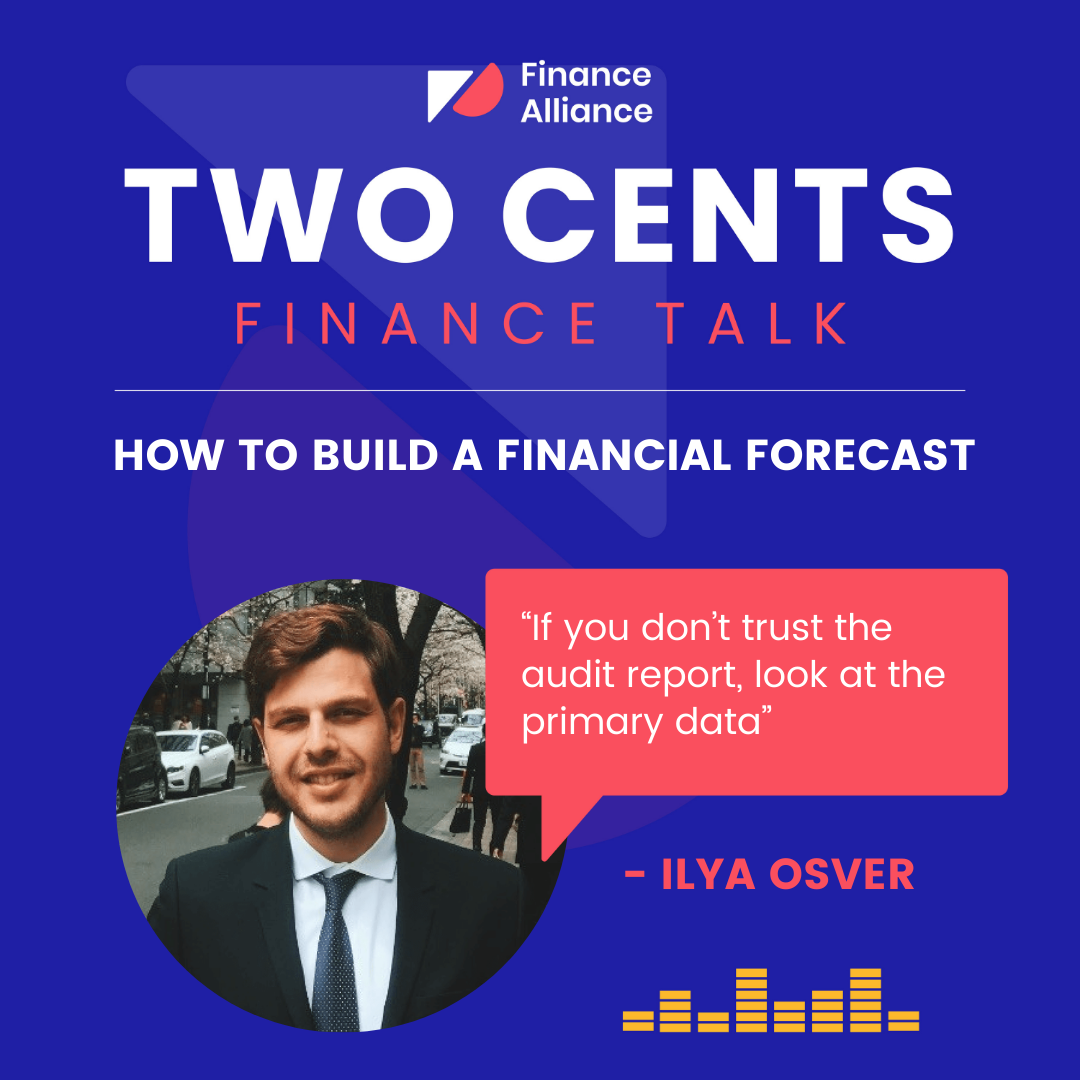Want to learn the basics of creating a financial forecast model? If so, you’ve come to the right place.
Whether you’re a Financial Analyst or the CFO sitting at the table with the ‘big players’ – you need a comprehensive understanding of financial forecasting.
Having a financial forecast model in place helps you identify what steps to take for continued growth and profitability. Put simply, financial forecasting predicts the future performance of the business.
But… what does a financial forecast look like? And how can you build one from the ground up?
Ilya Osver is a Financial Analyst with more than 14 years of experience. He revealed his best insider tips for creating a financial forecast model on the Two Cents: Finance Talk podcast.
We covered everything from the basics of building financial models on Excel to navigating frauds in financial standings. It’s a great conversation and one you don’t want to miss!
Tune in to this episode of the Two Cents podcast below:
Or keep reading to learn:
- What financial forecasting is (bringing it back to the basics!)
- The benefits of financial modeling
- What tools should be in your financial forecasting model ‘survival kit’
- How financial forecast models predict the future of the business
- How to create a financial forecast in Microsoft Excel
What is financial forecasting?
Financial forecasting predicts the future performance of an organization. You can build a financial forecasting model in Excel and use it to create income statements, financial statements, balance sheets, cash flow statements, pricing, and more.
Financial forecast models rely on historical data to build projections for the future financial performance of the organization. It’s worth noting that although financial forecast models are based on data, forecasting financial data relies on assumptions.
“It's not like predicting the future, even if it sounds like it. Rather, you're looking at the approval, a historical perspective, and trying to guess what's going on in the future. What you've done before, and what you did wrong before, will lead you to better results in the future.” – Ilya Osver.
The benefits of using a financial forecast model
As you can imagine, there are countless benefits of using a financial forecasting model, including:
- The ability to consider more than one potential outcome. You can test multiple scenarios to help ensure the business takes the right steps.
- A financial forecasting model provides you with insights and data into how the business operates. It also reveals what’s working well, and what areas need improvement. Having this data leads to better business decisions.
- Creates an in-depth valuation of your existing business planning model.
- You can make proper use of your budget and see what’s going on in the future and utilize your sources more wisely.
“With financial forecasting, you can prepare for anything, any crazy scenario that comes to your mind. You push some buttons in an Excel file and see what happens when the disaster comes.” – Ilya Osver.

What should be in your financial forecast model ‘survival kit’?
To create a financial forecasting plan, you need a balance sheet, profit/loss statement, and a cash flow statement. This is the basics.
You need these things to see...
- What you have on your balance
- What you owe
- Whom you owe
Using this data is the first level to creating an accurate financial forecast model.

The second level is reading the audit reports in full. Here’s Ilya’s advice when it comes to analyzing audit reports:
“Sometimes there's a hidden answer to your questions. So, you should read those audit reports carefully. And not just the tables and numbers! I know I know what people are thinking… people tend to scroll down to the figures and they lose a lot of information…”
“Look at the primary data if it's possible to obtain, meaning the root of your numbers in the balance sheet.”
“If you're a Financial Manager and you're looking at the figures thinking something is suspicious there, go directly to the department. Look at the papers because sometimes people make mistakes.” – Ilya Osver.

How a financial forecast model can predict the future of the business
When creating a financial forecast model, you take the historical data and try to see if there’s a way to replicate it in the future with some adjustments. Most banks use this approach.
For example, if a bank has a 10% growth last year, they assume that the following year will also see a 10% growth based on company records and financial projections.
However, Ilya warns that you need to be careful. You may think you’re growing because where you are now is 10 times higher than three years ago. But you might discover that you’re actually at a low when you push back 10 years or five years.
Another approach you can take to predict the future is using a driver-based forecast…
“You take the whole balance sheet and the whole P&L and multiply every item on the variable. You manipulate these numbers and figures and from my experience, the real picture is more negative…”
“But this helps you to reduce the risk in the future from also being more negative and using more variable single analysis and being more creative.” – Ilya Osver.

Tips for building a financial forecast model
You’ve got your blank Microsoft Excel sheet opened up in front of you. You’ve got all the data readily available. And, the mouse cursor is blinking away in the first cell…now what?
Here are Ilya’s forecasting method tips for creating a financial forecast model from the ground up using a spreadsheet:
First, you need an empty Excel file. In this Excel file, create the first sheet which will be your input sheet where you get your numbers inside your future system. The second sheet is where all your calculations and sums come together.
Many companies create separate financial standing and separate sheets. They have assets on one sheet, liabilities on the second, and equity on a third sheet where you’d find income statements.
“This is incredibly inconvenient because you don't want to jump from page to page to see the full picture. From a design standpoint, it looks much better. But my advice is to minimize the design and put it all on one page.” – Ilya Osver.
Emphasize what you want to calculate, why you wanted to calculate those things, and how you interpret it. That’s where you get the third page with an explanation. There, you answer questions about why you're doing this analysis. Then, write your explanations based on the research of your analysis on the previous page.
If you're doing something for your own company, you can have the file, and the third page of the text would be about what to expect. This is where you’ll put the pros and cons of your current financial standing.
Also, don’t forget to put insights on one page. It's very important (when using multiple pages) to link your formulas, otherwise, you could easily get lost. If you make a mistake, you could be spending hours trying to find it.
“The more you make, the more you practice, the better you’ll get. After 10 years, you can make a financial forecast model blindfolded!” – Ilya Osver
How often should you run a financial forecast?
There isn’t one concrete answer to this question. The number of times per year, month, or week, depends on your organization.
Financial analysts who work in the bank, like Ilya, may run a financial forecast every day. It's part of their daily duties. For those who are working as financial managers, once or twice a month seems to be average.
“If you’re a financial manager, I recommend you build a dashboard, which you’ll have in front of your eyes every day. This is an efficient way to know what's going on in your company from a financial point of view daily…”
“By having this information in front of your eyes, you’ll make faster and better decisions and you’ll be able to report to your boss more efficiently. And I'm pretty sure he/she will appreciate having those dashboards on their computer as well.” – Ilya Osver.
The future of financial forecast models
What does the future hold for financial forecasting?
I asked Ilya that question and this was his response:
“Five years ago, I thought there was no place for humans to do the analysis and everything with artificial intelligence…
Now, I can see we are still far away from achieving the proper result using AI. Humans still need to control these things.” – Ilya Osver
Ilya continued…
“The world is becoming clearer and more global as we share information. It’s become easier to predict the credibility of the company's financial standing. The figures are more real…”
Ilya then shared how he’d personally like to see financial forecasting models evolve:
“What we need is some type of automation, so we won't need to retype the data from the papers. This is the most boring part of my job. I'm just taking the paper and retyping it. I put the figures in the correct position, then edit it and relocate it properly.” – Ilya Osver
What advice would you give to aspiring or existing financial analysts who want to grow their careers?
Watch the video below to hear Ilya’s encouraging answer to this question:
Listen to a clip from ep.2 of the Two Cents: Finance Talk podcast with Ilya Osver - build a financial forecast model
About the guest
As a seasoned Financial Analyst, Ilya knows a thing or two about building financial models and forecasts. His current role at Rosbank includes many responsibilities such as overseeing daily operations, supporting the FO, business analysis, supervising core infrastructure projects, and more.
An independent and self-motivated Financial Analyst, Ilya has vast experience in analyzing the Financial Standings of Russian, EU, Japanese, Thai, Philippine and Indonesian companies. In fact, he has analyzed more than 3000 companies (wow!). He's passionate about data, technologies, and solving unsolvable problems.






